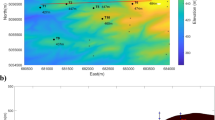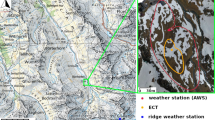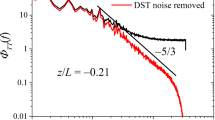Abstract
Previous laboratory and atmospheric experiments have shown that turbulence influences the surface temperature in a convective boundary layer. The main objective of this study is to examine land-atmosphere coupled heat transport mechanism for different stability conditions. High frequency infrared imagery and sonic anemometer measurements were obtained during the boundary layer late afternoon and sunset turbulence (BLLAST) experimental campaign. Temporal turbulence data in the surface-layer are then analyzed jointly with spatial surface-temperature imagery. The surface-temperature structures (identified using surface-temperature fluctuations) are strongly linked to atmospheric turbulence as manifested in several findings. The surface-temperature coherent structures move at an advection speed similar to the upper surface-layer or mixed-layer wind speed, with a decreasing trend with increase in stability. Also, with increasing instability the streamwise surface-temperature structure size decreases and the structures become more circular. The sequencing of surface- and air-temperature patterns is further examined through conditional averaging. Surface heating causes the initiation of warm ejection events followed by cold sweep events that result in surface cooling. The ejection events occur about 25 % of the time, but account for 60–70 % of the total sensible heat flux and cause fluctuations of up to 30 % in the ground heat flux. Cross-correlation analysis between air and surface temperature confirms the validity of a scalar footprint model.











Similar content being viewed by others
References
Balick LK, Jeffery CA, Henderson B (2003) Turbulence induced spatial variation of surface temperature in high resolution thermal IR satellite imagery. Proc SPIE 4879:221–230
Ballard JR, Smith JA, Koenig GG (2004) Towards a high temporal frequency grass canopy thermal IR model for background signatures. Proc SPIE 5431:251–259
Bastiaanssen WGM, Menenti M, Feddes RA, Holstag AAM (1998a) A remote sensing surface energy balance algorithm for land (SEBAL) 1 formulation. J Hydrol 212–213:198–212
Bastiaanssen WGM, Pelgrum H, Wang J, Ma J, Moreno JF, Roerink GJ, van der Wal T (1998b) A remote sensing surface energy balance algorithm for land (SEBAL) 2 validation. J Hydrol 212–213:213–229
Braaten DA, Shaw RH, Paw UKT (1993) Boundary-layer flow structures associated with particle reentrainment. Boundary-Layer Meteorol 65:255–272
Campbell GS, Norman JM (1998) An introduction to environmental biophysics. Springer, New York, 286 pp
Carslaw HS, Jaeger JC (1959) Conduction of heat in solids. Oxford University Press, London, 510 pp
Castellvi F (2004) Combining surface renewal analysis and similarity theory: a new approach for estimating sensible heat flux. Water Resour Res 40:W05201
Castellvi F, Snyder RL (2009) Combining the dissipation method and surface renewal analysis to estimate scalar fluxes from the time traces over rangeland grass near Ione (California). Hydrol Process 23:842–857
Castellvi F, Perez PJ, Ibanez M (2002) A method based on high-frequency temperature measurements to estimate the sensible heat flu avoiding the height dependence. Water Resour Res 38(6):1084
Christen A, Voogt JA (2009) Linking atmospheric turbulence and surface temperature fluctuations in a street canyon. Paper no. A3–6. The 7th international conference on urban climate, Yokohoma
Christen A, Voogt JA (2010) Inferring turbulent exchange process in an urban street canyon from high-frequency thermography. Paper no. J3A.3. 9th symposium on the urban environment, Keystone
Christen A, Meier F, Scherer D (2012) High-frequency fluctuations of surface temperatures in an urban environment. Theor Appl Climatol 108:301–324
Derksen DS (1974) Thermal infrared pictures and the mapping of microclimate. Neth J Agric Sci 22:119–132
Foken T, Wimmer F, Mauder M, Thomas C, Liebethal C (2006) Some aspects of the energy balance closure problem. Atmos Chem Phys 6:4395–4402
Gao W, Shaw RH, Paw UKT (1989) Observation of organized structure in turbulent flow within and above a forest canopy. Boundary-Layer Meteorol 47:349–377
Garai A, Kleissl J (2011) Air and surface temperature coupling in the convective atmospheric boundary layer. J Atmos Sci 68:2945–2954
Gurka R, Liberzon A, Hestroni G (2004) Detecting coherent patterns in a flume by using PIV and IR imaging techniques. Exp Fluids 37:230–236
Hestroni G, Rozenblit R (1994) Heat transfer to a liquid-solid mixture in a flume. Int J Multiphase Flow 20:671–689
Hestroni G, Kowalewski TA, Hu B, Mosyak A (2001) Tracking of coherent thermal structures on a heated wall by means of infrared thermography. Exp Fluids 30:286–294
Hommema SE, Adrian RJ (2003) Packet structure of surface eddies in the atmospheric boundary layer. Boundary-Layer Meteorol 106:147–170
Howard LN (1966) Convection at high Rayleigh number. In: Görtler H (ed) Proceedings of the 11th international congress on applied mechanics. Springer, San Diego, pp 1109–1115
Hsieh C-I, Katul GG, Chi T (2000) An approximate analytical model for footprint estimation of scalar fluxes in thermally stratified atmospheric flows. Adv Water Resour 23:765–772
Hunt JCR, Vrieling AJ, Nieuwstadt FTM, Fernando HJS (2003) The influence of the thermal diffusivity of the lower boundary on eddy motion in convection. J Fluid Mech 491:183–205
Jayalakshmy MS, Philip J (2010) Thermophysical properties of plant leaves and their influence on the environment temperature. Int J Thermophys 31:2295–2304
Kaimal JC, Businger JA (1970) Case studies of a convective plume and a dust devil. J Appl Meteorol 9:612–620
Kaimal JC, Wyngard JC, Haugen DA, Cote OR, Izumi Y (1976) Turbulence structure in the convective boundary layer. J Atmos Sci 33:2152–2169
Katul GG, Schieldge J, Hsieh C-I, Vidakovic B (1998) Skin temperature perturbations induced by surface layer turbulence above a grass surface. Water Resour Res 34:1265–1274
Katul GG, Konings AG, Porporato A (2011) Mean velocity profile in a sheared and thermally stratified atmospheric boundary layer. Phys Rev Lett 107:268502
Kormann R, Meixner FX (2001) An analytical footprint model for non-neutral stratification. Boundary-Layer Meteorol 99:207–224
Li D, Bou-Zeid E (2011) Coherent structures and the dissimilarity of turbulent transport of momentum and scalars in the unstable atmospheric surface layer. Boundary-Layer Meteorol 140:243–262
Lothon M, Lohou F, Durand P, Couvreux Sr. F, Hartogensis OK, Legain D, Pardyjak E, Pino D, Reuder J, Vilà Guerau de Arellano J, Alexander D, Augustin P, Bazile E, Bezombes Y, Blay E, van de Boer A, Boichard JL, de Coster O, Cuxart J, Dabas A, Darbieu C, Deboudt K, Delbarre H, Derrien S, Faloona I, Flament P, Fourmentin M, Garai A, Gibert F, Gioli B, Graf A, Groebner J, Guichard F, Jonassen M, van de Kroonenberg A, Lenschow D, Martin S, Martinez D, Mastrorillo L, Moene A, Moulin E, Pietersen H, Piguet B, Pique E, Román-Cascón C, Said F, Sastre M, Seity Y, Steeneveld GJ, Toscano P, Traullé O, Tzanos D, Wacker S, Yagüe C (2012) The boundary layer late afternoon and sunset turbulence 2011 filed experiment. Paper no. 14B.1. 20th symposium on boundary layers and turbulence, Boston
Oke TR (1987) Boundary layer climates. Methuen, London, 435 pp
Paw UKT, Brunet Y, Collineau S, Shaw RH, Maitani T, Qiu J, Hipps L (1992) On coherent structures in turbulence above and within agricultural plant canopies. Agric For Meteorol 61:55–68
Paw UKT, Qiu J, Su H-B, Watanabe T, Brunet Y (1995) Surface renewal analysis: a new method to obtain scalar fluxes. Agric For Meteorol 74:119–137
Raupach MR, Finnigan JJ, Brunet Y (1996) Coherent eddies and turbulence in vegetation canopies: the mixing-layer analogy. Boundary-Layer Meteorol 78:351–382
Renno NO, Abreu VJ, Koch J, Smith PH, Hartogensis OK, De Bruin HAR, Burose D, Delory GT, Farrell WM, Watts CJ, Garatuza J, Parker M, Carswell A (2004) MATADOR 2002: a pilot experiment on convective plumes and dust devils. J Geophys Res 109:E07001
Schols JLJ (1984) The detection and measurement of turbulent structures in the atmospheric surface layer. Boundary-Layer Meteorol 29:39–58
Schols JLJ, Jansen AE, Krom JG (1985) Characteristics of turbulent structures in the unstable atmospheric surface layer. Boundary-Layer Meteorol 33:173–196
Snyder RL, Spano D, Paw UKT (1996) Surface renewal analysis for sensible and latent heat flux density. Boundary-Layer Meteorol 77:249–266
Spano D, Snyder RL, Duce P, Paw UKT (1997) Surface renewal analysis for sensible heat flux density using structure functions. Agric For Meteorol 86:259–271
Spano D, Snyder RL, Duce P, Paw UKT (2000) Estimating sensible and latent heat flux densities from gravepine canopies using surface renewal. Agric For Meteorol 104:171–183
Sparrow EM, Husar RB, Goldstein RJ (1970) Observations and other characteristics of thermals. J Fluid Mech 41:793–800
Tiselj I, Bergant R, Makov B, Bajsić I, Hestroni G (2001) DNS of turbulent heat transfer in channel flow with heat conduction in the solid wall. J Heat Transf 123:849–857
Townsend AA (1959) Temperature fluctuation over a heated horizontal surface. Fluid Mech 5:209–241
Vogt R (2008) Visualisation of turbulent exchange using a thermal camera. Paper no. 8B.1. 18th symposium on boundary layer and turbulence, Stockholm
Wilczak JM, Businger JA (1983) Thermally indirect motions in the convective atmospheric boundary layer. J Atmos Sci 40:343–358
Wilczak JM, Tillman JE (1980) The three-dimensional structure of convection in the atmospheric surface layer. J Atmos Sci 37:2424–2443
Wilczak JM, Oncley SP, Stage SA (2001) Sonic anemometer tilt correction algorithms. Boundary-Layer Meteorol 99:127–150
Wyngaard JC, Cote OR, Izumi Y (1971) Local free convection, similarity and the budgets of shear stress and heat flux. J Atmos Sci 28:1171–1182
Acknowledgments
We thank (i) Daniel Alexander from University of Utah, USA; Dr. Marie Lothon, Dr. Fabienne Lohou, Solene Derrien from Laboratoire d’Aérologie, Université de Toulouse, France; Dr. Arnold Moene, Dr. Oscar Hartogensis, Anneke Van de Boer from Wageningen University, Netherlands for field assistance, data sharing and discussion; (ii) Peter Cottle and Anders Nottrott from University of California, San Diego for pre-experimental laboratory assistance and discussion about the data analysis respectively; (iii) BLLAST organizers for their hospitality during the experiment; (iv) funding from a NASA New Investigator Program award for AG and JK, and from INSU-CNRS (Institut National des Sciences de l’Univers, Centre national de la Recherche Scientifique, LEFE-IDAO program), Météo-France, Observatoire Midi-Pyrénées (University of Toulouse), EUFAR (EUropean Facility for Airborne Research) and COST ES0802 (European Cooperation in the field of Scientific and Technical) for the BLLAST field experiment.
Author information
Authors and Affiliations
Corresponding author
Electronic supplementary material
Below is the link to the electronic supplementary material.
Appendix
Appendix
The ogive function can be employed to estimate the sufficient averaging period for calculation of turbulent fluxes using the eddy-covariance method. Ogive \((og_{w.X} \left( {f_o } \right) )\) is a cumulative integral of the cospectrum, \(Co_{w,X}\), of a variable, \(X\), with vertical velocity, \(w\), starting with the highest frequency, \(f,\,og_{w.X} \left( {f_o } \right) =\int _\infty ^{f_0 } {Co_{w,X} \left( f \right) df}\). Ideally the ogive function increases during the integration from high frequency to small frequency, until reaching a constant value. Hence the period corresponding to the frequency at which the ogive reaches the constant value is considered to be sufficient to capture the largest turbulence scales. To improve the statistical significance and minimize the effect of diurnal cycles, twenty-six 30-min segments for each clear days corresponding to 0600–1900 UTC were used. It was found that a 5-min averaging period accounts for 90 and 85% of the maximum value of ogive for 2- and 8-m CSATs respectively for the sensible heat flux (Fig. 12) and the momentum flux (not shown). Thus an averaging period of 5-min was selected.
Rights and permissions
About this article
Cite this article
Garai, A., Pardyjak, E., Steeneveld, GJ. et al. Surface Temperature and Surface-Layer Turbulence in a Convective Boundary Layer. Boundary-Layer Meteorol 148, 51–72 (2013). https://doi.org/10.1007/s10546-013-9803-4
Received:
Accepted:
Published:
Issue Date:
DOI: https://doi.org/10.1007/s10546-013-9803-4





